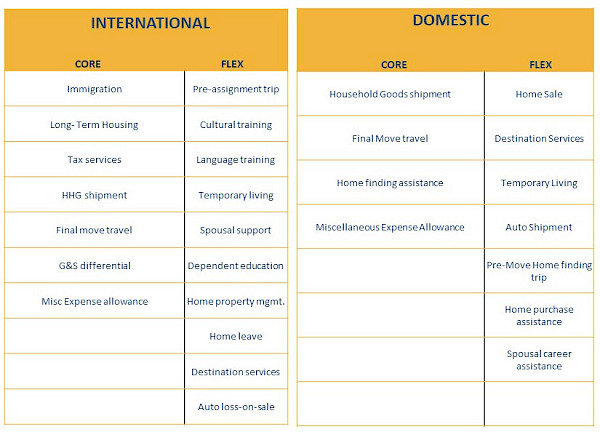As companies seek to review and redesign their relocation policies, many are asking: What is Core / Flex? Is it right for our company?
We understand the interest and the attraction. The name “Core/Flex” itself hints at perfection: the perfect combination of consistency and flexibility! But is it that simple?
Bristol’s view is that, indeed, a well-designed core-flex approach has the potential to be among the most sophisticated and effective policy frameworks – if the conditions and company culture are right. But we would not propose core/flex as a simple solution or one that is right for every company. It is an approach that needs to be designed very carefully, with copious internal stakeholder input, that ultimately requires very focused ongoing internal management. Core/flex is not a “plug-and-play” policy type per se, but more a phrase that describes a carefully constructed custom approach that looks very different from company to company. Very often it is designed to meet the needs of a complex organization with multiple business units and/or Talent Acquisition teams filling a variety of roles. It is a structure that allows for and guides a high degree of individual negotiation within certain confines. It is an approach worth investigating for a sophisticated company whose culture demands flexibility.
CORE/FLEX: Management Summary
Overview
- Utilized by estimated 15-20% of companies (WERC)
- Policy presents a combination of:
- “Core” policy provisions – provided to all transferees
- Optional benefits according to individual needs
- Selection of optional benefits typically made by business unit / recruiter, with input and negotiation from employee/candidate, and advice from Global Mobility
- Designed to meet the specific needs of the hiring manager, the candidate, and business variables
- Flex benefits often adheres to a pre-set budget
Advantages
- Can tailor relocation benefits more closely to employee or candidate needs
- Empower hiring managers, business units, regional locations to make decisions that are right for them
- Gain a recruiting edge for top talent
- Make transferees feel more valued and invested in the process
- Control costs - offering only those benefits that are meaningful to the employee
- Reduce exceptions
Disadvantages
- Program/policy administration is more complex than for strictly defined, tiered policies
- Requires close collaboration and education between HR and business units
- Budgeting can be less predictable due to variable policy elements
- Continuing management involvement is crucial to ensure that each package includes all of the elements essential to a successful relocation/assignment
- Inconsistent treatment / insufficient benefits can lead to employee dissatisfaction
Example
Bristol recently worked with a client to design a core/flex policies starting with the following core and flex provisions:
Note: Not comprehensive. For discussion purposes only.

Core components were provided as managed services according to need. Flex components were assigned modest budgetary amounts adding up to an overall budget that could be apportioned more or less across each of the flexible provisions.
We have much more to share on this topic, including specific budget targets for the provisions above.
Talk to Bristol!
Bristol’s Consulting department assists our clients in evaluating, benchmarking and improving their mobility policies to meet the specific requirements of their unique businesses. For advice on how to apply the concepts discussed in this article, or for any related questions, please contact your Bristol account director or reach us at info@bristolglobal.com to discuss how we may assist you!